Learn how to make fermented fruit two ways, for results that are not only delicious, but full of probiotics. Fermented blueberries are a sweet way to eat healthy bacteria. Find 2 ways to preserve fruit below.
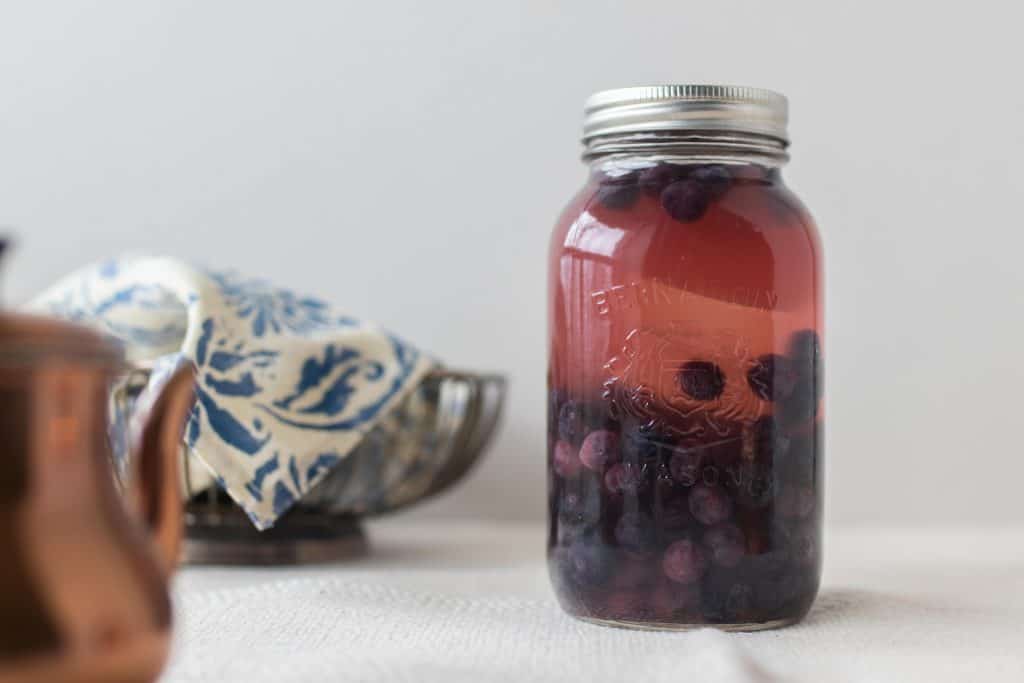
If you’ve been around here for more than two minutes, you know my deep passion for all things fermented.
From sauerkraut to sour cream to sourdough, and all things in between.
Bacteria – the good kind, of course – may just be my favorite type of food.
We have fermented foods multiple times a day, and my kids beg for kefir soda.
This has been a busy spring on the homestead. We recently planted an orchard that we will be continuing to add to, and we’ve also started to plant a variety of blueberry and raspberry plants.
Our harvest won’t be much this year, but with time and patience, we will be reaping an abundance for years to come.
Hopefully, more than enough to preserve and ferment.
Today, I’m going to show you how to ferment blueberries, but you could also try cherries, pineapple, and raspberries.
Health Benefits Of Fermented Fruit
There are so many reasons to love fermented foods. They’re rich in probiotics, which have been shown to help improve gut health by improving the gut micro-biome, aid in digestion, and increase immune functions (since much of immune function lies in the gut).
It can also increase vitamins like A, B, C, and K, making the vitamins and minerals more bio-available for absorption.
Tips For Making Fermented Fruit
- For quality of ingredients, you will want to choose non-iodized salt, filtered water, and organic fruit when fermenting.
- You can also use frozen blueberries, but the blueberries melt down into a more mashed up/syrupy consistency. Fruit ferments quicker than vegetables. Make sure to test it every day after 24-48 hours, because it can cross the threshold into alcohol quickly.
- With fruit fermentations, it is best if they have a jump starter culture like the whey, water kefir, or kombucha, so they will ferment quickly and not turn into alcohol.
- Make these recipes in small batches, because they will not last more than a few weeks in the fridge.
This post contains affiliate links, which means I make a small commission at no extra cost to you. See my full disclosure here.
Is fermented fruit safe to eat?
Fermented fruit is safe to eat as long as you follow directions, use clean jars and tools, and don’t overferment your fruit.
Always check for signs of mold, and if it smells or looks funky, toss it.
What does fermented fruit taste like?
This will depend on the fermentation method you choose.
The first method uses salt and will be a salty, tangy ferment. The second method gives you a sweeter ferment and is preferred for enjoying fermented fruit to top yogurt and ice cream.
Can fermented foods make you sick?
Any food can make you sick, and fermented foods are no different. There are a few precautions: if it smells bad or looks moldy, toss it out.
Remember that fermented fruit does not last as long (only a few weeks) compared to fermented vegetables (which can lasts months, even up to a year).
Tools You May Need:
Mason jars
Jar lids or pickle pipes – I love these silicon pickle pipes.
Kitchen scale (for method 1)
Bowl
Measuring cup and spoons
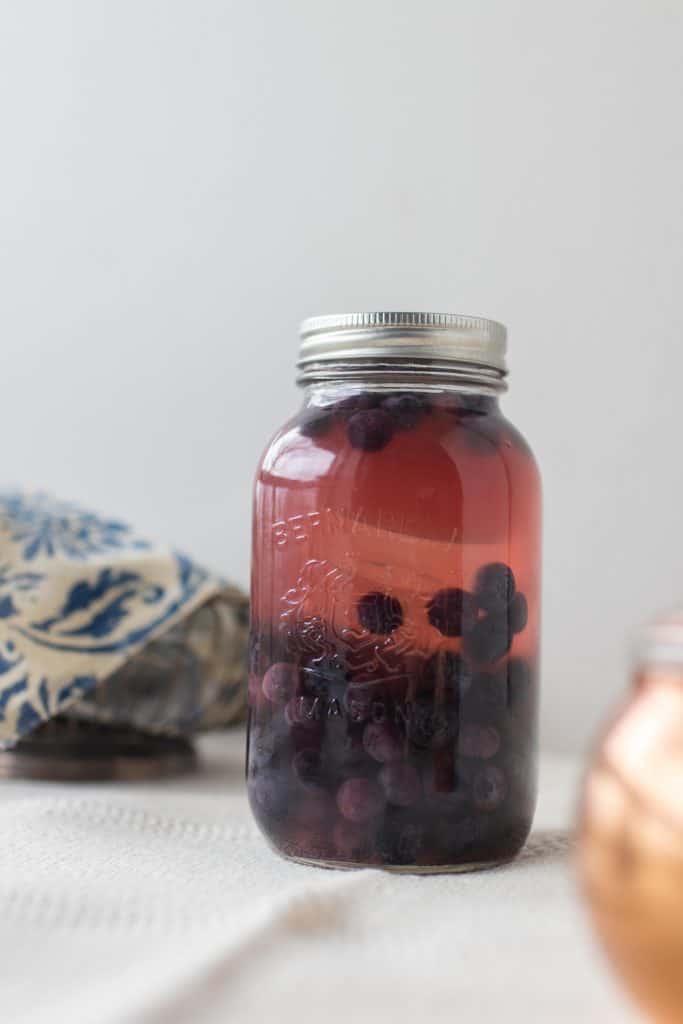
How To Make Fermented Fruit:
Here are two different ways to ferment fruit. The first one includes a salt brine, while the second is a sweet sugar brine.
Method 1: Fermented Fruit With 2% Salt
Ingredients:
Salt – Use non-iodized salt when fermenting.
Blueberries
Directions:
- You will need 2% salt to have a successful fermentation. Weigh blueberries in grams to determine how many grams of salt you need.
- Example: if you have 300 grams of blueberries, you’ll need to add 6 grams of salt. To get this number, I calculated 300 (g) x 0.02 = 6g.
- You can leave the blueberries intact, or you can lightly crush them to open the skins.
- Add blueberries to a bowl and sprinkle salt over. Mix. Pour into a jar and add a weight.
- It’s important to keep oxygen out of your mason jar or fermenting vessel.
- The easiest way to do this is with a fermentation weight, or you can put a food storage bag inside the jar, and fill it with water.
- Place a lid on the jar and seal it loosely, because this mixture will bubble and the air bubbles will need to escape.
- After 24 hours, begin tasting your ferment every day until it is the perfect level of fermentation for you.
- For this method, it typically takes anywhere from three to seven days, depending on the storage temperature for the jar. This will be a much saltier final product than method 2.
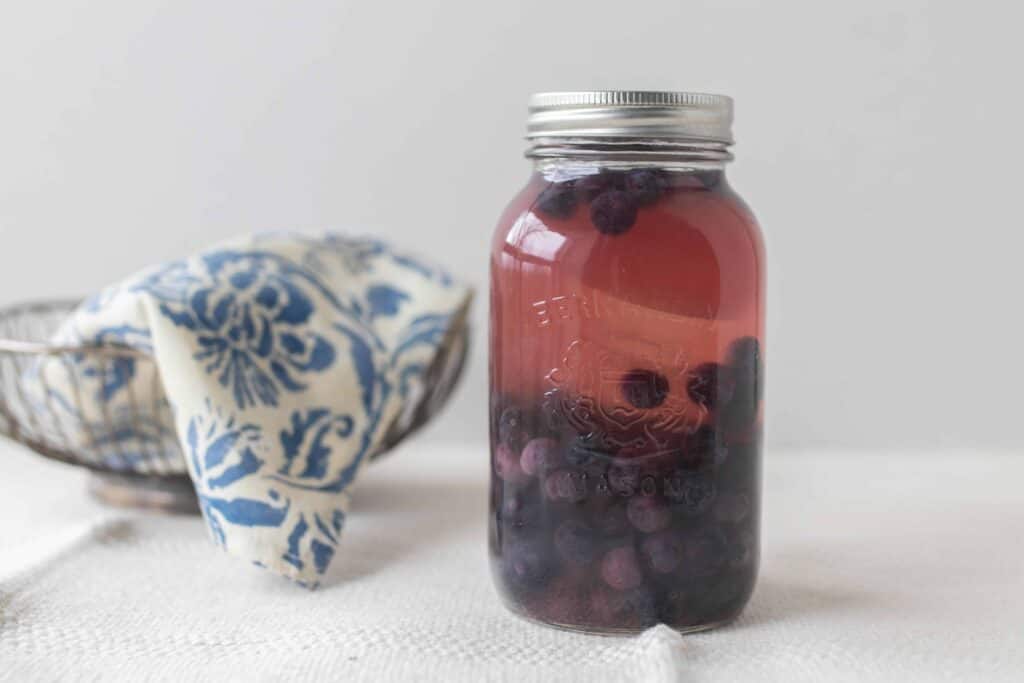
Method 2: Fermented Fruit In A Sugar Brine Solution
Ingredients:
- 2 cups of blueberries
- 6 tbsp of kombucha or whey or water kefir liquid
- 3⁄4 tsp of good quality salt
- 6 tbsp of organic cane sugar
- 9 tbsp of filtered water
Directions:
- Heat water slightly.
- In a jar, add sugar and salt. Pour in warm water and stir to dissolve. Allow to cool.
- Once the water is cool, add remaining ingredients.
- Weigh down fruit with a fermentation weight, like a food storage bag filled with water or a small glass jar that fits inside a wide mouth mason jar. All the fruit must stay below the brine.
- Add a loose lid on the jar or use a pickle pipe to allow the gasses to release. After 24 hours, taste daily until your ferment reaches the desired taste.
Where Can I Get Whey?
I strained my own whey from homemade yogurt using cheesecloth, and then I enjoyed some Greek yogurt. It worked perfectly! You can also do this with store-bought yogurt.
How To Use Your Fermented Fruit
- Blend into smoothies
- Blend into homemade popsicles
- Top yogurt or ice cream
- Mash into a jam (don’t heat)
- Blend into homemade ice cream
- Blend into salad dressings
- Balsamic fermented blueberry dressing (recipe coming soon!)
- Puree fermented blueberries as condiment for meats
Find More Of My Favorite Ferments:
How To Make A Sourdough Starter From Scratch
Lacto-Fermentation Guide: How To Ferment Any Vegetable
If you make this recipe and love it, I would love if you gave it 5 stars! Tag me on Instagram @farmhouseonboone with your delicious creation.
Fermented Fruit
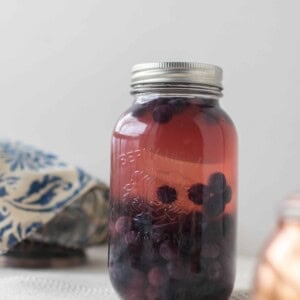
Ingredients
Method 1: Salt Brine
- Salt – Use non-iodized salt when fermenting.
- Blueberries
Method 2:
- 2 cups blueberries
- 6 tablespoons kombucha or whey or water kefir liquid
- 3/4 teaspoon good quality salt
- 6 tablespoons organic cane sugar
- 9 tablespoons filtered water
Instructions
Method 1: Salt Brine
- You will need 2% salt to have a successful fermentation. Weigh blueberries in grams to determine how many grams of salt you need.
Example: if you have 300 grams of blueberries, you’ll need to add 6 grams of salt. To get this number, I calculated 300 (g) x 0.02 = 6g. - Add blueberries to a bowl and sprinkle salt over. Mix.
- Pour into a jar and add a weight.
- Place a lid on the jar and seal it loosely, because this mixture will bubble and the air bubbles will need to escape.
- After 24 hours, start to taste your ferment every day until it is the perfect level of fermentation for you.
- For this method, it typically takes anywhere from three to seven days, depending on the storage temperature for the jar.
Method 2: Sugar Brine Solution
- Heat water slightly.
- In a jar, add sugar and salt. Pour in warm water and stir to dissolve. Allow to cool.
- Once the water is cool, add remaining ingredients.
- Weigh down fruit with a fermentation weight. All the fruit must stay below the brine.
- Add a loose lid on the jar or use a pickle pipe to allow the gasses to release. After 24 hours, taste every day until your ferment reaches the desired taste.
Notes
- For quality of ingredients, you will want to choose non-iodized salt, filtered water, and organic fruit when fermenting.
- You can also use frozen blueberries, but the blueberries melt down into a more mashed up/syrupy consistency.
- Fruit ferments quicker than vegetables. Make sure to test it every day after 24-48 hours, because it can cross the threshold into alcohol quickly.
- With fruit fermentations, it is best if they have a jump starter culture like the whey, water kefir, or kombucha, so they will ferment quickly and not turn into alcohol.
- Make these recipes in small batches, because they will not last more than a few weeks in the fridge.
Nutrition
Nutrition information is automatically calculated, so should only be used as an approximation.
Pin It For Later
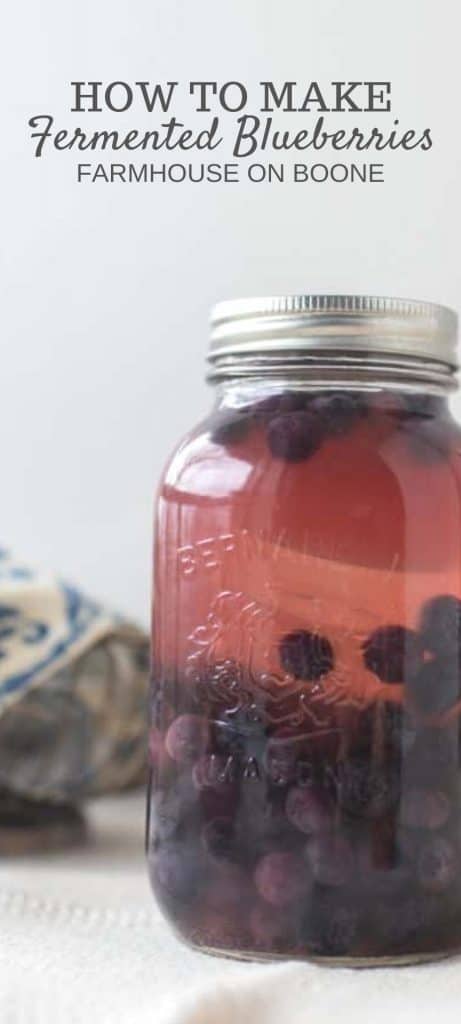










nice, easy, effective
Hi thank you for this information. Can dried fruit such as dates or raisins be fermented please?
I do not think so. I have never tried.
How much water do you use for each of these methods?
Method #2 uses 9 tbsp of filtered water
Hello, I was wondering if it would be safe to ferment the blueberries using the kombucha at room temperature like how kombucha is made? Thanks!
I have not personally tried this.
Hi— I just found my basement freezer unplugged. This means I have about 2 gallons or more of fermented cherries picked from my tree. Anything I can do with this many? Is it safe?
Please help! I’m not sure what to do— and it’s such a waste to compost so many…. Maybe not a waste. Arg I’m at a loss.
I’m so sorry, that is really frustrating. I’m not sure as it would depend on how long the freezer was unplugged for. Sorry I don’t have any answers for you.
Can I use frozen blueberries or do they need to be fresh?
Thoughts on a lesser salt percentage, such as 1%? I find 2% a bit too salty.
You need at least 2% to keep the bacteria at bay. You can always rinse the fruit/ vegetables after they have fermented and before using, as needed to reduce some of the salt , but don’t cut back in the fermentation or storage phase.
Would that rinse off the probiotic or does it not work that way?
Did you leave water out of the first recipe intentionally? Seems like there should be water in there instead of just berries and salt, especially if you’re calling for a weight to be used. Thank you.
Did you ever get an answer? I’m wondering the same. Just started this ferment today.
The water will draw out of the fruit. You don’t need to add water. If you do, you need to adjust you salt amount to account for the addition. Standard lacto fermentation for pickling you mix salt into the food matter as stated in the directions given. Adding water will give you something more like a salty kvass or a drink instead of fermented fruit.
You need at least 2% salt by weight to keep bacteria at bay
Hi Lisa, great article. I used to ferments lots of vegetables, maybe cranberries but I have a big project in front of me today – replay asap requested. I have, in my freezer, about 20 lbs of saskatoons, raspberries, strawberries, blackberries, even cherries, persimmon pulp, pomegranate and mixed fruit. some organic, some not. I need to empty my freezer and don’t want endless jars of jam. So, it occurred to me to ferment. A) can I use frozen fruit or are the microorganisms dead? Any workaround? B) As a retired beekeeper, I have some 200 lbs of honey, 1/2 pail at 30% moisture fermented a bit, (I use it in my coffee etc). Can I use this? c) can I use fresh brine from a just finished container of feta? Thanks for your wisdom.
Thanks for the nice website and great article on fermenting fruit. Besides the two you shared, there’s another even sweeter way to ferment fruit – in Honey! I’m currently tending jars of honey fermenting with (in different jars) cranberries, blueberries, ginger, green fennel seed (saved from my garden) and garlic. Check it out sometime.
Is it possible to get the recipes with honey?